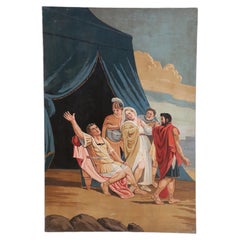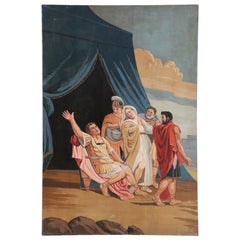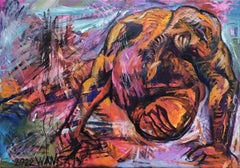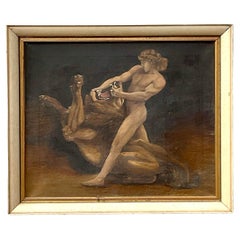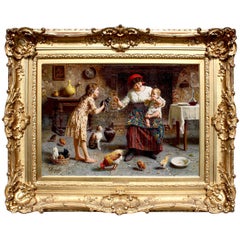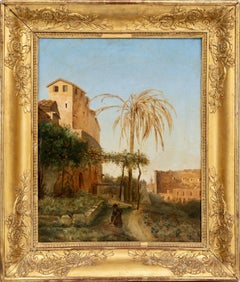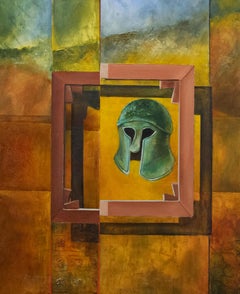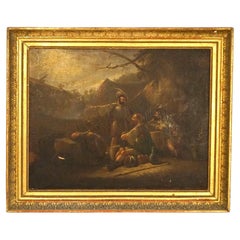Gladiator Oil Paintings
Heroic Gladiator and Blue Tent Oil Painting on Canvas
Located in New York, NY
Vintage (20th Century) unframed canvas oil painting of a gladiator seated in front of a blue tent
Category
20th Century American Mid-Century Modern Paintings
Materials
Canvas
Heroic Gladiator and Blue Tent Oil Painting on Canvas
Located in New York, NY
Vintage (20th century) unframed canvas oil painting of a gladiator seated in front of a blue tent
Category
20th Century American Mid-Century Modern Paintings
Materials
Canvas
Heroic Gladiator and Blue Tent Oil Painting on Canvas
Located in New York, NY
Vintage (20th Century) unframed painting of a gladiator seated in front of a blue tent with gold
Category
20th Century American Mid-Century Modern Paintings
Materials
Canvas
Heroic Gladiator and Blue Tent Oil Painting on Canvas
Located in New York, NY
Vintage (20th Century) unframed painting of a gladiator seated in front of a blue tent with gold
Category
20th Century American Mid-Century Modern Paintings
Materials
Canvas
Wounded gladiator, 80x110cm
By Tatiana Levchenko
Located in Yerevan, AM
Wounded gladiator, 80x110cm
Category
2010s Contemporary Abstract Paintings
Materials
Canvas, Oil, Acrylic
Race Horse Phoenix with Guilermo Kemmis - British 19th century art oil painting
Located in London, GB
This superb British 19th century equine oil painting is by noted horse lover, George Gascoyne
Category
1880s Realist Animal Paintings
Materials
Oil
Vintage Grand Tour Gladiator Original Oil on Canvas
Located in west palm beach, FL
Vintage grand tour painting depicting a gladiator holding a lions mouth open. A combination of soft
Category
Mid-20th Century American Grand Tour Prints
Materials
Canvas, Wood, Paint
Eugenio Zampighi 'Italian, 1859-1944' 19th/20th C. Oil on Canvas "Joyous Family"
By Eugenio Zampighi
Located in Los Angeles, CA
Eugenio Zampighi (Italian, 1859-1944) A fine and charming Italian 19th/20th century oil on canvas
Category
Antique Early 1900s Italian Country Paintings
Materials
Gesso, Canvas, Giltwood
H 35 in W 43.25 in D 4.5 in
Roman Colosseum of Italy by Catherine Colosimo
By Catherine Colosimo
Located in Montreal, Quebec
her father’s love of painting and craftsmanship and, at a young age discovered her love of art and her
Category
21st Century and Contemporary Landscape Paintings
Materials
Canvas, Oil
Colosseum and San Bonaventura al Palatino seen from its Garden. Circa 1830.
Located in Stockholm, SE
. 1830-1840 and set in a decorated Swedish gilt frame from the period. It is possible that the painting
Category
1830s Italian School Landscape Paintings
Materials
Canvas, Oil
H 13 in W 16.54 in D 2.37 in
Recent Sales
John Voss - Surrealist 20th Century Oil, Gladiator
Located in Corsham, GB
surrealist still life shows a Roman gladiator helmet, floating strangely in the middle of a fragmented square
Category
20th Century Portrait Paintings
Materials
Oil
Antique Oil Painting of Three Gladiators, Old Master Copy Dated 1860
Located in Big Flats, NY
An antique old master painting offers oil on canvas scene with three gladiators in countryside
Category
Antique Mid-19th Century Paintings
Materials
Paint
20th Century British abstract painting 'Gladiator' by Roger Smith, in blues
Located in Petworth, West Sussex
Roger Smith (British, 1932 – 2004)
Gladiator
Oil on board
Signed on reverse but obscured by box
Category
20th Century Abstract Abstract Paintings
Materials
Oil, Board
H 24 in W 15 in D 1 in
PORTRAIT of a Young Girl in Roman Dress c.1695, Antique Oil Painting EDWARD BYNG
Located in London, GB
Portrait of a young girl in Roman costume c.1695, Antique Oil Painting
Attributed to Edward Byng (c
Category
17th Century Old Masters Portrait Paintings
Materials
Oil, Canvas
H 33.86 in W 28.75 in D 1.97 in
Christy Mathewson and Walter Johnson Original Oil Painting by Arthur Miller
By Arthur Miller
Located in Colorado Springs, CO
painting two of baseball’s most celebrated professionals—the great Christy Mathewson and the legendary
Category
21st Century and Contemporary American Paintings
Materials
Canvas
Antique Oil Painting by Eugenio Zampighi Titled News from the Front 1885
By Eugenio Zampighi
Located in London, GB
This is a beautiful oil on canvas painting titled 'News from the front' by the renowned Italian
Category
Antique 1880s Italian Paintings
Materials
Canvas
H 33.08 in W 40.95 in D 1.97 in
"Ruin Landscape" ("Capriccio"), Oil on Canvas, Possibly Circle of Panini
By Giovanni Paolo Panini
Located in Madrid, ES
of it and the sculpture, giving harmony to the painting (background, a series of arches visually
Category
Antique 18th Century Italian Neoclassical Paintings
Materials
Canvas
H 38.98 in W 49.22 in L 38.98 in
19th Century Gladiator Painting
Located in Los Angeles, CA
Oil painting of a Gladiator moments away from entering the ring. Gazing into the arena as he is
Category
Antique 19th Century European Neoclassical Paintings
Materials
Canvas, Wood, Paint
19th century oil painting of a horse - Bay Middleton winner of the Epsom Derby
By John Frederick Herring Sr.
Located in Antwerp, BE
. Gladiator, by Partisan (W. Scott), second, Mr J. Day’s b. c. Venison, by Partisan (j. Day), third; also
Category
19th Century Romantic Animal Paintings
Materials
Canvas, Oil
'rome' abstract expressionist, Scandinavian artwork
Located in Lahti, FI
"Rome
Wasn't built in a day
Rome
Memories in a frame
Rome
Getting past gladiators
Having fun
Category
2010s Abstract Expressionist Abstract Paintings
Materials
Canvas, Oil Pastel, Oil, Acrylic, Pencil, Color Pencil
H 35.83 in W 25.99 in D 0.79 in
Get Updated with New Arrivals
Save "Gladiator Oil Paintings", and we’ll notify you when there are new listings in this category.
Questions About Gladiator Oil Paintings
- What is abstract oil painting?1 AnswerLilac Gallery Ltd.March 17, 2021An abstract oil painting and an artwork that is made with oil paint on a medium like canvas, wood board, or other panels like canvas board. And the 'abstract' term refers to the Movement & Style of the piece. As abstraction indicates a departure from reality in the depiction of imagery in art, the artist creates a painting where the subject, shape, form, color, and line, is created with no particular references of the world but as a composition that may exist with a degree of independence from its vision.
- 1stDibs ExpertMarch 22, 2024To maintain oil paintings that you purchased for your home, experts suggest that you keep them out of direct sunlight. Prolonged exposure to the sunlight coming in from a window can fade the colors in your painting. Do not hang your oil painting near a heat source or where it can get wet (bathrooms and kitchens are not safe for your oil painting).
You may wish to dust your oil painting so that layers of dust don’t begin to gather on its surface. This should only be considered to remove loose dust. Never spray any chemical substance on your oil painting. Do not use a damp cloth to dust your oil painting. (Again, your painting should not be exposed to moisture.)
To remove loose dust, use a soft brush that measures approximately one to two inches wide with natural-hair bristles. Do not use a dust cloth or a feather duster, as those items may catch or leave threads or feathers behind. Do not apply pressure or dust your painting for an extended period of time.
If you think that your oil painting is considerably dirty or believe that other issues may be at work, experts strongly suggest that you consult with a professional conservator.
Read about how to arrange your wall art and find oil paintings for sale on 1stDibs. - 1stDibs ExpertFebruary 13, 2024To identify an oil painting, look closely at its surface. Compared to other paintings, pieces produced in oils usually show off a variety of textures across the canvas, and the paint will appear layered on. If you're looking to determine the name, age or creator of a work, try snapping a photo with your smartphone’s camera and conducting a reverse image search online. Shop a diverse assortment of oil paintings on 1stDibs.
- When was oil paint invented?1 Answer1stDibs ExpertFebruary 27, 2024Oil paint was invented during the 7th century A.D. The earliest examples of oil paintings have been traced to Afghanistan and depict scenes related to the Buddhist religion. Records dating back to the 12th century indicate that early Christian monks in Europe used oil paints to decorate furniture, and a century later, some artists began finishing tempera paintings with touches of oil paint. It wasn't until the 15th century that oil paints became a common medium for European painters, when Flemish artists like Jan van Eyck began favoring them over tempera. Explore a variety of oil paintings on 1stDibs.
- 1stDibs ExpertMay 3, 2024Jan van Eyck is widely considered by art historians to be the father of oil painting. While the usage of oil paints dates back to 7th-century China, the Flemish painter popularized the material, using oils to produce highly detailed works such as The Arnolfini Portrait. The Northern Renaissance master also influenced many other artists, such as Hugo van der Goes and Gerard David. Shop an assortment of fine art on 1stDibs.
- 1stDibs ExpertApril 5, 2022To find the artist of an oil painting, look on the back of the canvas. Sometimes, you will find the artist’s name and the year of production on the back. If the canvas is in a frame, gently peel away the paper covering the back to access the canvas. In the event you cannot find any identifying information, seek the help of a licensed art appraiser. Shop a selection of oil paintings on 1stDibs.
- La ChrysomeleFebruary 24, 2021Any artwork is worth and only worth the price someone is willing to pay for it (unfortunately, whether one can afford it or not is another story). Different people may have different reasons to attribute value to an artwork, from the purest (falling in love with it) to what is often considered as the most vile (speculation), going through remembrance, pride of ownership, or brag, among other reasons. For most living artists, the price of the artworks is usually set by the artist and/or the gallery which represent him or her, by type and size of artwork, and corresponds to an equilibrium price between the rate at which artworks are sold and the rate at which new artworks are produced by the artist. For artworks from dead artists sold by professional dealers, the price is often based on auctions results for similar pieces of the same artists. Oil paintings are usually pricier than other techniques because it is considered more difficult to master, but also because oil paintings are known for their ability to last centuries.
- 1stDibs ExpertApril 5, 2022To tell if your oil painting is authentic, first check the signature of the artist to start your research. Use a magnifying glass to check the texture of the painting, and finally check the back for the painting’s original stretchers. Shop a selection of expertly vetted artwork from some of the world’s top art dealers on 1stDibs.
- 1stDibs ExpertFebruary 13, 2023Because the value of an oil painting can vary greatly based on the artist, the subject and the condition of the piece, it's generally best to work with a certified appraiser. A knowledgeable professional can evaluate the piece and estimate its value. Shop a variety of authentic oil paintings from some of the world’s top galleries on 1stDibs.
- 1stDibs ExpertApril 5, 2022The best place to find oil paintings and discover new artists is at local art galleries. There are also many online art dealers who provide information about artists and sell their works. On 1stDibs, you’ll discover a variety of art styles from master oil painters.
- 1stDibs ExpertMarch 22, 2024Yes, sunlight affects oil paintings. Keep your oil paintings away from direct sunlight.
To maintain oil paintings that you purchased for your home, experts suggest that you keep them out of sunlight. Prolonged exposure to the sunlight coming in from a window can fade the colors in your painting. Do not hang your oil painting near a heat source or where it can get wet (bathrooms and kitchens are not safe for your oil painting).
You may wish to dust your oil painting so that layers of dust don’t begin to gather on its surface. This should only be considered to remove loose dust. Never spray any chemical substance on your oil painting. Do not use a damp cloth to dust your oil painting. (Again, your painting should not be exposed to moisture.)
To remove loose dust, use a soft brush that measures approximately one to two inches wide with natural-hair bristles. Do not use a dust cloth or a feather duster, as those items may catch or leave threads or feathers behind. Do not apply pressure or dust your painting for an extended period of time.
If you think that your oil painting is considerably dirty or believe that other issues may be at work, experts strongly suggest that you consult with a professional conservator.
Read about how to arrange your wall art and find oil paintings for sale on 1stDibs. - How much do oil paintings cost?1 Answer1stDibs ExpertSeptember 25, 2019
On 1stdibs, oil paintings cost between $60 and $6,200,000.
- 1stDibs ExpertMarch 22, 2024Yes, oil paintings darken over time. As oil paint is made of pigment particles, the range of substances that are used as pigment in oil paint can render certain colors susceptible to aging. Slowing the aging process for an oil painting involves storing your painting properly and keeping the work out of exposed sunlight. Temperature control and humidity are also important in preserving the life of an oil painting and slowing the aging process.
To maintain oil paintings that you purchased for your home, experts suggest that you keep them out of direct sunlight. Prolonged exposure to the sunlight coming in from a window can fade the colors in your painting. Do not hang your oil painting near a heat source or where it can get wet (bathrooms and kitchens are not safe for your oil painting).
You may wish to dust your oil painting so that layers of dust don’t begin to gather on its surface. This should only be considered to remove loose dust. Never spray any chemical substance on your oil painting. Do not use a damp cloth to dust your oil painting. (Again, your painting should not be exposed to moisture.)
To remove loose dust, use a soft brush that measures approximately one to two inches wide with natural-hair bristles. Do not use a dust cloth or a feather duster, as those items may catch or leave threads or feathers behind. Do not apply pressure or dust your painting for an extended period of time.
If you think that your oil painting is considerably dirty or believe that other issues may be at work, experts strongly suggest that you consult with a professional conservator.
Read about how to arrange your wall art and find oil paintings for sale on 1stDibs. - 1stDibs ExpertMay 3, 2024A few things make an oil painting valuable. Age has a major impact on price, with pieces made over a century ago tending to fetch the highest prices. Who created the painting also matters. The more famous the artist, the higher the selling price for a painting is likely to be. Finally, the condition of the work and whether it is in its original frame will also impact how much it is worth. Find a diverse assortment of oil paintings on 1stDibs.
- Did Dali use oil paint?1 Answer1stDibs ExpertApril 5, 2022Yes, Dali did indeed use oil paint. Although he used oil paints in the traditional method, he would at times add natural resin or linseed oil to play with fluidity and texture. You can shop a selection of Salvador Dali’s pieces from some of the world’s top art dealers on 1stDibs.
- Can you use oil paint on wood?1 Answer1stDibs ExpertFebruary 22, 2021You can use oil paint on wood as long as you prep the wood first. The first thing you should do is seal the wood with a primer. Ideally, paint two coats of sealer onto the wood so that the paint doesn't cause the wood to rot over time.
- 1stDibs ExpertApril 5, 2022The largest oil painting in the world is in the main hall of the Doge's Palace located in Venice, Italy. Its name is Il Paradiso. Tintoretto painted it around 1592, and it measures 22 meters by 7 meters. Shop a large collection of oil paintings on 1stDibs.
- 1stDibs ExpertSeptember 25, 2019
Varnishing an oil is not necessary, but it is recommended because it protects the painting and corrects surface irregularities.
- 1stDibs ExpertSeptember 25, 2019
Oils typically command higher prices than acrylic paintings, because they generally require more skill.
- Lilac Gallery Ltd.March 18, 2021The cost of an original oil painting has a very wide range. For emerging new artist could be in the lower end, ranging from the $500 to $10,000 depending on the size and subject matter, for the mid-career artists who are already established, their prices range in the thousands and hundreds of thousands of dollars and lastly the original oil painting art of very established and popular artists that could have auction records in the millions of dollars. In this category are some of the well known examples of the old master paintings and other contemporary artworks.


